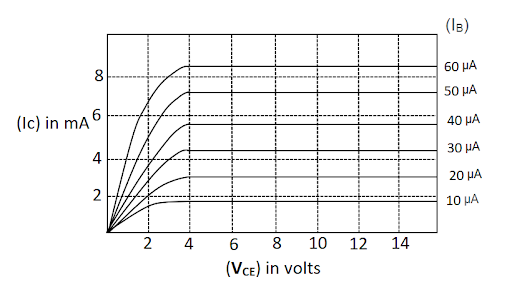
The output characteristics of a transistor is shown in the figure. When \[{V_{CE}}\] is 10V and \[{I_C}\]= 4.0 mA, then the value of \[{\beta _{ac}}\] is __________.

Answer
217.2k+ views
Hint:A transistor is defined as a semiconductor device used to conduct an electric current or electric voltage. For a transistor, the three terminals are base, collector and emitter. When we combine the expressions for \[\alpha \] and \[\beta \] the mathematical relationship between these parameters then we get the current gain of the transistor. By using the relation, we can find the value for \[\beta \].
Formula used:
The mathematical relationship between these parameters can be given as:
\[\alpha = \dfrac{{{I_C}}}{{{I_E}}}\] and \[\beta = \dfrac{{{I_C}}}{{{I_B}}}\]
\[\Rightarrow {I_C} = \alpha {I_E} = \beta {I_B}\]
As \[\alpha = \dfrac{\beta }{{\beta + 1}}\]
\[\beta = \dfrac{\alpha }{{1 - \alpha }}\]
\[{I_E} = {I_C} + {I_B}\]
Where \[{I_C}\] is the current in the collector terminal, \[{I_B}\] is the current in the base terminal and \[{I_E}\] is the current in the emitter terminal.
Complete step by step solution:
A transistor can also use a small signal which is applied between one pair of its terminals to control a large signal at the other pair of terminals. This property is known as gain. A stronger output signal can produce a voltage as well as a current which is dependable on a weaker input signal.
\[\beta = \dfrac{{\Delta {I_c}}}{{\Delta {I_B}}}\]
Substituting the values
\[\Delta {I_B} = 30 - 20{I_C} = 4\,mA\]
\[\Rightarrow \Delta {I_C} = 4.5 - 3 = 1.5\,mA\]
Now \[\beta = \dfrac{{1.5 \times {{10}^{ - 3}}}}{{10 \times {{10}^{ - 6}}}}\]
\[\therefore \beta = 150\]
Therefore, the value of \[{\beta _{ac}}\] is 150.
Note: In physics, for any transistor the graph shows the relationships between the current(I) and the voltage (V) for any configuration is known as transistor characteristics. The current transfer properties curve can define the variation of output current to the input current by keeping the output voltage constant. There are three transistor circuit configurations. These are Common Emitter Transistor, Common Base Transistor and Common Collector Transistor.
Formula used:
The mathematical relationship between these parameters can be given as:
\[\alpha = \dfrac{{{I_C}}}{{{I_E}}}\] and \[\beta = \dfrac{{{I_C}}}{{{I_B}}}\]
\[\Rightarrow {I_C} = \alpha {I_E} = \beta {I_B}\]
As \[\alpha = \dfrac{\beta }{{\beta + 1}}\]
\[\beta = \dfrac{\alpha }{{1 - \alpha }}\]
\[{I_E} = {I_C} + {I_B}\]
Where \[{I_C}\] is the current in the collector terminal, \[{I_B}\] is the current in the base terminal and \[{I_E}\] is the current in the emitter terminal.
Complete step by step solution:
A transistor can also use a small signal which is applied between one pair of its terminals to control a large signal at the other pair of terminals. This property is known as gain. A stronger output signal can produce a voltage as well as a current which is dependable on a weaker input signal.
\[\beta = \dfrac{{\Delta {I_c}}}{{\Delta {I_B}}}\]
Substituting the values
\[\Delta {I_B} = 30 - 20{I_C} = 4\,mA\]
\[\Rightarrow \Delta {I_C} = 4.5 - 3 = 1.5\,mA\]
Now \[\beta = \dfrac{{1.5 \times {{10}^{ - 3}}}}{{10 \times {{10}^{ - 6}}}}\]
\[\therefore \beta = 150\]
Therefore, the value of \[{\beta _{ac}}\] is 150.
Note: In physics, for any transistor the graph shows the relationships between the current(I) and the voltage (V) for any configuration is known as transistor characteristics. The current transfer properties curve can define the variation of output current to the input current by keeping the output voltage constant. There are three transistor circuit configurations. These are Common Emitter Transistor, Common Base Transistor and Common Collector Transistor.
Recently Updated Pages
Addition of Three Vectors: Methods & Examples

Addition of Vectors: Simple Guide for Students

Algebra Made Easy: Step-by-Step Guide for Students

Relations and Functions: Complete Guide for Students

Analytical Method of Vector Addition Explained Simply

Arithmetic, Geometric & Harmonic Progressions Explained

Trending doubts
JEE Main 2026: Application Form Open, Exam Dates, Syllabus, Eligibility & Question Papers

Derivation of Equation of Trajectory Explained for Students

Hybridisation in Chemistry – Concept, Types & Applications

Understanding the Angle of Deviation in a Prism

Understanding Collisions: Types and Examples for Students

How to Convert a Galvanometer into an Ammeter or Voltmeter

Other Pages
JEE Advanced Marks vs Ranks 2025: Understanding Category-wise Qualifying Marks and Previous Year Cut-offs

Understanding Atomic Structure for Beginners

Ideal and Non-Ideal Solutions Explained for Class 12 Chemistry

Degree of Dissociation: Meaning, Formula, Calculation & Uses

Understanding Electromagnetic Waves and Their Importance

Understanding the Electric Field of a Uniformly Charged Ring




